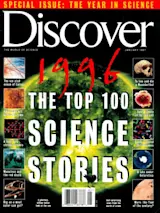The images at right of Earth’s aurora borealis--the shimmering lights created by particles of solar wind crashing into the polar atmosphere--were taken on April 9 by the UltraViolet Imager, an instrument on board nasa’s polar satellite. The images show with unprecedented clarity both the dayside aurora, seen here over northern Canada, and the nightside aurora over Siberia. At ultraviolet wavelengths, there is less reflected sunlight to swamp the dayside aurora, and the uvi filters out most of what there is. Most, but not all--which is why the dayside aurora looks even brighter than the nightside one here. In reality, the aurora is most intense on the nightside. As charged particles stream in from the sun, explains Jim Spann, a physicist at nasa’s Marshall Space Flight Center in Huntsville, Alabama, Earth’s magnetic field deflects them into a long tail that trails behind the planet. This magnetotail is a reservoir that traps ...
Bird's-Eye Aurora
Discover Earth’s aurora borealis captured by NASA's UltraViolet Imager, revealing stunning details of the nightside aurora.
More on Discover
Stay Curious
SubscribeTo The Magazine
Save up to 40% off the cover price when you subscribe to Discover magazine.
Subscribe













